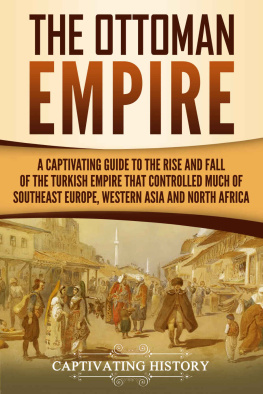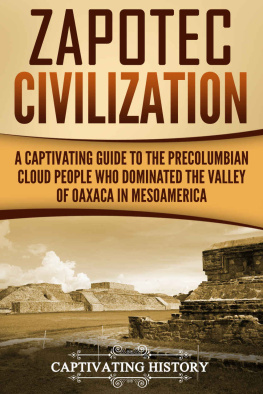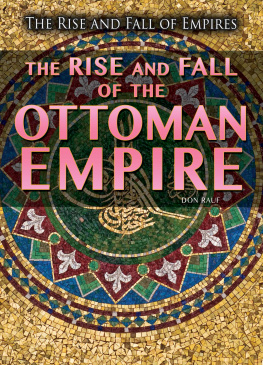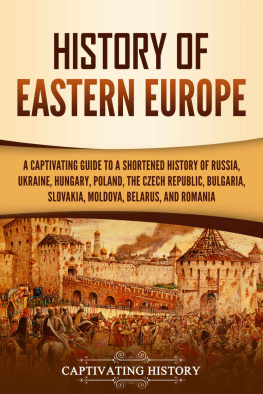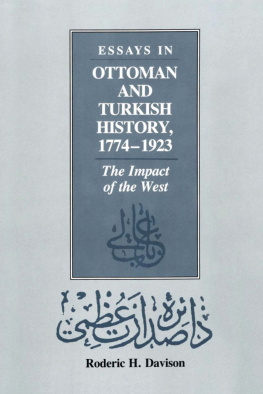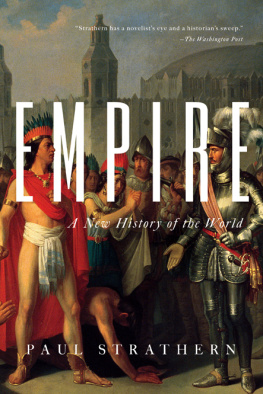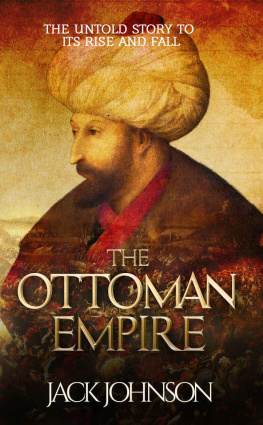History - The Ottoman Empire: A Captivating Guide to the Rise and Fall of the Turkish Empire and its Control Over Much of Southeast Europe, Western Asia, and North Africa
Here you can read online History - The Ottoman Empire: A Captivating Guide to the Rise and Fall of the Turkish Empire and its Control Over Much of Southeast Europe, Western Asia, and North Africa full text of the book (entire story) in english for free. Download pdf and epub, get meaning, cover and reviews about this ebook. year: 2018, genre: Science. Description of the work, (preface) as well as reviews are available. Best literature library LitArk.com created for fans of good reading and offers a wide selection of genres:
Romance novel
Science fiction
Adventure
Detective
Science
History
Home and family
Prose
Art
Politics
Computer
Non-fiction
Religion
Business
Children
Humor
Choose a favorite category and find really read worthwhile books. Enjoy immersion in the world of imagination, feel the emotions of the characters or learn something new for yourself, make an fascinating discovery.
- Book:The Ottoman Empire: A Captivating Guide to the Rise and Fall of the Turkish Empire and its Control Over Much of Southeast Europe, Western Asia, and North Africa
- Author:
- Genre:
- Year:2018
- Rating:4 / 5
- Favourites:Add to favourites
- Your mark:
- 80
- 1
- 2
- 3
- 4
- 5
The Ottoman Empire: A Captivating Guide to the Rise and Fall of the Turkish Empire and its Control Over Much of Southeast Europe, Western Asia, and North Africa: summary, description and annotation
We offer to read an annotation, description, summary or preface (depends on what the author of the book "The Ottoman Empire: A Captivating Guide to the Rise and Fall of the Turkish Empire and its Control Over Much of Southeast Europe, Western Asia, and North Africa" wrote himself). If you haven't found the necessary information about the book — write in the comments, we will try to find it.
History: author's other books
Who wrote The Ottoman Empire: A Captivating Guide to the Rise and Fall of the Turkish Empire and its Control Over Much of Southeast Europe, Western Asia, and North Africa? Find out the surname, the name of the author of the book and a list of all author's works by series.
The Ottoman Empire: A Captivating Guide to the Rise and Fall of the Turkish Empire and its Control Over Much of Southeast Europe, Western Asia, and North Africa — read online for free the complete book (whole text) full work
Below is the text of the book, divided by pages. System saving the place of the last page read, allows you to conveniently read the book "The Ottoman Empire: A Captivating Guide to the Rise and Fall of the Turkish Empire and its Control Over Much of Southeast Europe, Western Asia, and North Africa" online for free, without having to search again every time where you left off. Put a bookmark, and you can go to the page where you finished reading at any time.
Font size:
Interval:
Bookmark:
A Captivating Guide to the Rise and Fall of the Turkish Empire and Its Control Over Much of Southeast Europe, Western Asia, and North Africa
Copyright 2018
All Rights Reserved. No part of this book may be reproduced in any form without permission in writing from the author. Reviewers may quote brief passages in reviews.
Disclaimer: No part of this publication may be reproduced or transmitted in any form or by any means, mechanical or electronic, including photocopying or recording, or by any information storage and retrieval system, or transmitted by email without permission in writing from the publisher.
While all attempts have been made to verify the information provided in this publication, neither the author nor the publisher assumes any responsibility for errors, omissions or contrary interpretations of the subject matter herein.
This book is for entertainment purposes only. The views expressed are those of the author alone, and should not take as expert instruction or commands. The reader is responsible for his or her actions.
Adherence to all applicable laws and regulations, including international, federal, state and local laws governing professional licensing, business practices, advertising and all other aspects of doing business in the US, Canada, UK or any other jurisdiction is the sole responsibility of the purchaser or reader.
Neither the author nor the publisher assumes any responsibility or liability whatsoever on behalf of the purchaser or reader of these materials. Any perceived slight of any individual or organization is purely unintentional.
Hi History Lovers!
My name is Matt Clayton, and Im the creator of Captivating History. First off, I want to THANK YOU for reading our books in the Captivating History series. As an avid reader of History myself, I aim to produce books that will hold you captive.
Now you have a chance to join our exclusive history list so you can get the ebook below for free as well as discounts and a potential to get more history books for free! Simply click the link below to join.
P.S. If you join now, you will also receive a free Mythology book. Remember that its 100% free to join the list.

Click here to access your bonus
Also, make sure to follow us on:
Twitter: @Captivhistory
Facebook: Captivating History: @captivatinghistory
The Ottoman world was nothing like an exotic fairytale featuring tyrant sultans, mean pashas, and ill-fated harem women. The true stories of genuine sultans and princes are a bit more complicated but no less exciting. This society was not a backwards one, as Western thought presented it around a century ago, by calling it The Sick Man of Europe. That image was created during the period of the states irreversible decline. For centuries, the Ottoman Empire had been a dominant force with a clear hierarchy, advanced administration (similar to the Roman system of provinces), and wise rulers. Bad rulers were usually regarded as crazy, then overthrown or killed so that they couldnt harm their subjects and do damage to the empire.
At first, the Ottomans (known as the Osmanli at the time) were merely one among many Turkish tribes that populated Anatolia. Then, in 1301, they encountered and devastated a Byzantine army at Bapheus near Constantinople. The Byzantine failure was due to unfortunate circumstances, but within a century, the Ottoman force was indeed on par with the Eastern Roman Empire. Eventually, this Turkish empire not only evolved, but also became the sole inheritor of both Byzantine and other Turkish (e.g., Seljuk) states.
Incredible facts about this empire still surprise anyone who starts discovering these stories. Youll find out that, for quite a while, this Islamic state was effectively ruled by women, and thats just the beginning. Youll learn that the Ottomans knew how to keep their enemies close and how sometimes they used them to resolve internal issues. Several sultans paid Byzantine emperors to keep their brothers (those that they hadnt managed, or didnt want, to kill) confined. When the Ottomans conquered Constantinople, and the Byzantines became history, one sultan still received this same servicefrom the Pope.
For six hundred years, Ottoman forces threatened not only European armies but also those of Iran and other Muslim countries and regions. At the same time, Ottoman architects constructed the impressive mosques that still present the most memorable buildings in cities throughout the empire. Military might and construction works may be the most apparent signs of power, but the real strength came from the inside. The Ottomans produced a comprehensive legal system that was flexible enough to deal with the complicated ethnic and cultural issues found in the Balkans and the Middle East.
The Ottoman story had begun somewhere during the years 699-700 in the Islamic calendar, which corresponds to 1299 AD. The beginning was not spectacular; no epic battles took place at that particular moment. The land that was to become the Ottoman territory belonged to the Eastern Roman Empire (Byzantium) and was ruled from Constantinople. The land of the Osmanli was close to Constantinople, which meant they could hope for great rewards should they manage to conquer the city. On the other hand, the Byzantine army was determined to protect its capital, and it wasnt easy for a Turkish tribe to persist in such conditions. Somehow, the Ottomans one of many Turkish (or Turkoman) tribes that threatened the Byzantine borders and the one that was closest to the firebuilt their resilience and started dreaming an imperial dream.
Two centuries earlier, in the eleventh century, another tribe, the Seljuk Turks, invaded the eastern frontier of the Christian Byzantium. The Turks then migrated into the Middle East and Anatolia and toward the Byzantine coastlines. Near the end of the twelfth century, they grew so strong that they defeated the Byzantine army led by the Emperor Manuel I Comnenus. The Byzantine forces were weak during the Fourth Crusade, and the Turks were able to expand almost effortlessly. However, their domination was not meant to last. Soon after the peak of the Seljuks success, another invader came and overwhelmed the Turks. The mighty Mongol army, led by the successors of the formidable Genghis Khan, sacked the territories of the Seljuks.
The Mongols did not intend to stay in Anatolia and the Balkans, and they left shortly after, but the situation in the region was now much different than it had been when they came. Instead of a single Seljuk empirewhich was taking shape when the new invaders appeared at the beginning of the fourteenth centurythere were numerous Turkish emirates in Anatolia. One of them was the emirate of Osman, the founder of the Ottoman Empire. Their time had just begun.
Various Turkish tribes had already occupied the eastern shores of the Mediterranean Sea. Organized as emirates or beyliks (principalities), they led the holy war against the Eastern Roman Empire. Influenced by their highly sophisticated enemy, they abandoned the nomadic way of life and chose to settle, cultivate the land, and even organize a tax system.
New tribes and families kept arriving. Some of the newcomers were wealthy enough to buy ships from Christian traders and use them to invade the coastlines of Thrace and Greece. Many Greek border guards changed their side after Byzantium failed to protect their borderlines. However, there were also many footloose warriors, adventurists, landless peasants, misfits, and runaways from all around the world, and even Christians.
Font size:
Interval:
Bookmark:
Similar books «The Ottoman Empire: A Captivating Guide to the Rise and Fall of the Turkish Empire and its Control Over Much of Southeast Europe, Western Asia, and North Africa»
Look at similar books to The Ottoman Empire: A Captivating Guide to the Rise and Fall of the Turkish Empire and its Control Over Much of Southeast Europe, Western Asia, and North Africa. We have selected literature similar in name and meaning in the hope of providing readers with more options to find new, interesting, not yet read works.
Discussion, reviews of the book The Ottoman Empire: A Captivating Guide to the Rise and Fall of the Turkish Empire and its Control Over Much of Southeast Europe, Western Asia, and North Africa and just readers' own opinions. Leave your comments, write what you think about the work, its meaning or the main characters. Specify what exactly you liked and what you didn't like, and why you think so.

